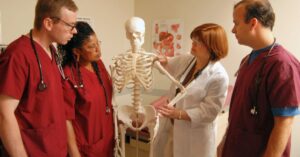Pain is one of the most common and challenging symptoms nurses encounter across all healthcare settings. Whether acute, chronic, or procedure-related, pain significantly affects patients’ quality of life, functional status, and psychological wellbeing. As frontline caregivers, nurses play a vital role in assessing, documenting, and managing pain effectively. Understanding evidence-based pain management in nursing is critical to providing compassionate and holistic care.
This comprehensive guide explores modern pain management strategies, the role of nurses, pharmacologic and non-pharmacologic interventions, patient-centred care models, and the ethical dimensions of treating pain. It also highlights the importance of interdisciplinary collaboration and ongoing education to improve outcomes in pain management in nursing.
In This Article
Understanding Pain in Clinical Practice
What Is Pain?
Pain is a subjective, multidimensional experience involving physical, emotional, and psychological responses to tissue damage or potential harm. The International Association for the Study of Pain (IASP) defines it as “an unpleasant sensory and emotional experience associated with, or resembling that associated with, actual or potential tissue damage.”
Types of Pain in Nursing
Understanding pain classification is essential in pain management in nursing:
- Acute Pain: Short-term, often linked to surgery, injury, or illness.
- Chronic Pain: Persistent pain lasting longer than three months.
- Neuropathic Pain: Resulting from nerve damage (e.g., diabetic neuropathy).
- Nociceptive Pain: Caused by tissue injury (e.g., post-operative pain).
- Referred Pain: Felt in an area different from the source (e.g., heart attack pain in the arm).
- Breakthrough Pain: Sudden flare-ups of pain despite ongoing treatment.
The Role of Nurses in Pain Management
Nurses are often the first to assess and act on a patient’s report of pain. In pain management in nursing, their responsibilities include:
- Pain Assessment using standardised tools.
- Monitoring effectiveness of interventions.
- Educating patients and families about pain relief options.
- Advocating for appropriate pain control.
- Documenting pain levels and treatment responses.
Pain management in nursing also involves recognising subtle non-verbal cues in non-communicative patients, such as infants, those with dementia, or intubated individuals.
Pain Assessment Tools for Nurses
Accurate pain assessment is a foundation for effective intervention. Tools commonly used in pain management in nursing include:
- Numeric Rating Scale (NRS): 0 (no pain) to 10 (worst pain).
- Visual Analog Scale (VAS): A horizontal line indicating pain intensity.
- Faces Pain Scale-Revised (FPS-R): Used for children or those with communication difficulties.
- PAINAD Scale: For assessing pain in patients with advanced dementia.
- McGill Pain Questionnaire: Offers detailed insights into pain quality and location.
Frequent reassessment after interventions ensures care remains responsive and patient-centred.
Pharmacological Interventions in Nursing Pain Management
1. Non-Opioid Analgesics
Commonly used for mild to moderate pain:
- Paracetamol (Acetaminophen)
- NSAIDs (e.g., ibuprofen, diclofenac)
Nursing Considerations:
- Monitor for gastrointestinal bleeding and renal function.
- Assess for allergies and contraindications.
2. Opioids
Used for moderate to severe pain (e.g., morphine, fentanyl, oxycodone).
Nursing Role:
- Assess pain relief, sedation, respiratory rate.
- Watch for tolerance, dependence, and constipation.
- Use opioid conversion charts to prevent overdose.
3. Adjuvant Analgesics
Drugs not primarily designed for pain but effective in certain conditions:
- Antidepressants (e.g., amitriptyline for neuropathic pain)
- Anticonvulsants (e.g., gabapentin for nerve pain)
- Steroids, Muscle Relaxants, and Anaesthetics
Non-Pharmacological Pain Management Strategies
Pain management in nursing is not limited to medications. Holistic, non-drug approaches are equally essential.
1. Physical Techniques
- Positioning and Mobility: Repositioning, using pillows, reducing pressure areas.
- Heat and Cold Therapy: Ice packs reduce inflammation; heat soothes chronic pain.
- Massage and Touch Therapy: Stimulates circulation and relaxes tense muscles.
- Acupuncture and TENS Units: Effective in chronic and musculoskeletal pain.
2. Psychological Techniques
- Cognitive Behavioural Therapy (CBT): Helps reframe thoughts around pain.
- Relaxation and Guided Imagery: Reduces anxiety and muscle tension.
- Mindfulness Meditation: Encourages present-moment awareness to reduce suffering.
3. Environmental and Spiritual Care
- Calm, quiet rooms with soft lighting can reduce distress.
- Spiritual support, including chaplain visits or personal rituals, supports coping.
Multimodal Pain Management
A key strategy in modern pain management in nursing is multimodal analgesia—combining different types of treatments for synergistic effects. This approach reduces the need for opioids and enhances overall patient comfort.
Example:
Paracetamol + NSAID + regional anaesthesia + TENS therapy + patient education.
Benefits:
- Lower doses of each drug
- Fewer side effects
- Enhanced functional recovery
Nurses play a crucial role in monitoring and integrating these approaches.
Cultural Considerations in Pain Management
Pain is experienced and expressed differently based on culture, upbringing, and belief systems. Pain management in nursing must be culturally competent.
Tips for Culturally Sensitive Nursing Care:
- Ask about pain beliefs and preferred remedies.
- Use interpreters for clear communication.
- Respect non-verbal communication and family involvement in decision-making.
- Avoid stereotypes—individualise care.
Pain Management in Special Populations
1. Paediatric Pain
Children may not always verbalise pain clearly.
Nursing Strategies:
- Use child-specific tools (e.g., FLACC, Wong-Baker FACES).
- Offer distraction (e.g., play, storytelling).
- Involve parents in comfort techniques.
2. Older Adults
Often under-report pain due to fear of side effects or “being a burden.”
Nursing Tips:
- Use simple scales (e.g., NRS).
- Monitor for polypharmacy risks.
- Include cognitive screening for appropriate interpretation.
3. Patients with Cognitive Impairments
Non-verbal cues become essential.
Observation Points:
- Facial grimacing
- Restlessness
- Moaning
- Increased heart rate or blood pressure
Use PAINAD or Abbey Pain Scale for structured assessment.
Ethical and Legal Aspects of Pain Management in Nursing
Nurses have a professional and ethical duty to manage pain.
Ethical Principles:
- Beneficence: Relieve suffering.
- Non-maleficence: Avoid harm from overmedication or neglect.
- Autonomy: Respect patient choices on pain management.
- Justice: Equal access to effective pain relief.
Legal Considerations:
- Document pain assessments and interventions accurately.
- Know state and facility policies on opioid administration.
- Be aware of scope of practice when using complementary techniques.
Interdisciplinary Collaboration in Pain Management
Pain management in nursing requires teamwork:
- Physicians: Diagnose and prescribe.
- Pharmacists: Recommend dosages and manage interactions.
- Physiotherapists: Support movement therapy.
- Psychologists: Help manage emotional responses.
- Social Workers: Connect to community support and palliative resources.
Nurses are the coordinators who ensure that all parts of the plan work harmoniously.
Technology in Pain Management
Electronic Pain Diaries
Allow patients to log pain levels in real time, improving trend analysis.
Smart Pumps
Deliver controlled analgesia with programmed limits to reduce overdose risk.
Virtual Reality
Used for burn dressing changes and procedural anxiety with promising results.
Nurses must stay up-to-date with such innovations to enhance pain management in nursing effectively.
Barriers to Effective Pain Management
Even with best intentions, pain may remain poorly controlled due to:
- Inadequate training
- Fear of addiction
- Patient reluctance to report pain
- Communication barriers
- Time constraints
- Understaffing
Ongoing nurse education, open dialogue, and system-level changes are needed to address these barriers.
Continuing Education and Skill Development
To improve pain management in nursing, ongoing training is essential. Nurses should pursue:
- Workshops on pain assessment tools
- Courses in pharmacology and symptom control
- Updates on opioid regulations and alternatives
- Simulation-based training in palliative care
Healthcare facilities should support mentorship, peer reviews, and evidence-based guidelines to raise standards.
Patient and Family Education in Pain Control
Educating patients improves compliance and outcomes.
Topics Nurses Should Cover:
- How to use pain scales
- Importance of timely medication
- Managing expectations
- Home remedies and red flags
- When to seek emergency care
Empowering patients makes them partners in pain relief, not passive recipients.
Palliative and End-of-Life Pain Management
Comfort is the priority in end-stage disease. Pain management in nursing at this stage focuses on:
- Continuous assessments
- Opioid titration for comfort
- Family support
- Honouring dignity and choices
Use of subcutaneous and transdermal routes becomes more common when oral intake is limited.
Case Studies: Pain Management in Nursing Practice
Case 1: Post-Op Pain
Patient: 45-year-old post-knee replacement
Intervention: PCA morphine + cold compress + TENS
Outcome: Pain reduced from 8/10 to 3/10 within 24 hours
Case 2: Cancer Pain
Patient: 60-year-old with metastatic colon cancer
Intervention: Long-acting morphine, massage therapy, spiritual counselling
Outcome: Better sleep, reduced emotional distress, improved appetite
Case 3: Dementia
Patient: 85-year-old with Alzheimer’s and hip fracture
Observation: Facial grimacing, guarding leg
Nursing Response: Paracetamol + gentle repositioning + family presence
Outcome: Calmer behaviour, improved feeding
These real-world examples reinforce the importance of individualised and compassionate pain management in nursing.
Must Read:
- Cultural Competence in Nursing: Why It Matters?
- Medicaid Cuts: Impact on Nursing Homes and Elderly Care
- Nursing Education: Embracing Technology and Competency-Based Learning
Conclusion: Future of Pain Management in Nursing
Pain management in nursing continues to evolve, driven by patient advocacy, new research, and technological advances. The holistic approach blending medical, emotional, and psychological care is essential for lasting relief.
Key takeaways:
- Nurses must assess, act, and advocate consistently.
- Combining drug and non-drug interventions offers optimal results.
- Cultural, ethical, and emotional elements cannot be ignored.
- Interdisciplinary cooperation ensures continuity and depth of care.
- Continued education and patient involvement are the pillars of progress.
As healthcare systems grow more patient-centric, the future of pain management in nursing rests in personalised care, science-informed compassion, and a dedication to relieving suffering in all its forms.







